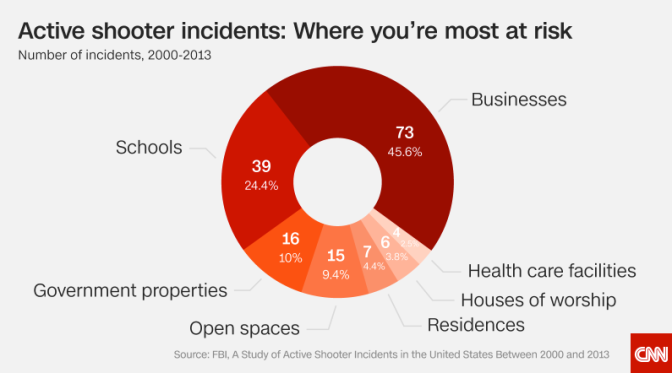Statistics
There were 330 mass shootings recorded in 2015 and 280 in 2014.
As of May 1, 2016, there were 126 recorded mass shooting events, according to Mass Shooting Tracker, a calculation which includes suicide.
As of May 1, 2016, there were 93 recorded mass shootings, according to the Gun Violence Archive.
There were 64 school shootings in 2015.
Public massacres like Sandy Hook or Virginia Tech account for only 1 in 6 mass killings.
Here’s a graphic produced by CNN about where active shooter incidents are most likely to occur:

The majority of mass shootings — 53 percent — are family related, according to USA Today. 57 percent of victims knew the shooter even if they were not the main target of the attack.
Handguns make up 73 percent of weapons used in mass shootings. Rifles make up nearly 20 percent.
About 25 percent of shooters kill themselves before being captured by law enforcement officials.
13,286 people were killed in the U.S. by firearms in 2015, though most not in mass shootings. More people are killed by guns in suicide attempts rather than homicides.
There are about 300 million guns in America, but only 1 in 3 households is armed.
About Trauma
Trauma can have many different meanings. It can make a person:
- Lose faith that there is a lack or absence of order and continuity in life
- Feel as if there is no safety in the world
- Disconnect and believe that they have no place to go to
There are three types of trauma
- Acute Traumatic Events
- These traumatic experience occur at a particular time and place. These traumatic experiences are typically short-lived.
- Examples: school shootings, terrorist attacks, natural disasters
- Chronic traumatic situations
- These traumatic experiences consist of repeated, long durations of being exposed to the trauma and violence.
- Examples: sexual abuse, physical abuse, domestic violence
- Historical Trauma
- These traumatic experiences impact entire communities. The community cumulatively experiences the emotional and psychological wounds and the trauma transmits across generations.
- Examples: Holocaust, Civil Rights Movement, Vietnam War
The effects of traumatic events vary from person to person. Traumatic experiences lay heavy burdens on individuals, families and communities. Adults and children experience trauma differently. Most people prove to be resilient while others battle to restore order in their lives.
Post Traumatic Stress
Post Traumatic Stress Disorder was formalized as a medical diagnosis in 1980 when it was added to the DSM-III. Prior to 1980, the disorder had many different names: Soldier’s Heart, Railway Spine, shell shock and others.
PTSD is a mental health condition that develops in some people who have lived through or seen a terrifying event. It is natural for people to respond to traumatic experiences with a “fight or flight” response in order to protect themselves from further harm. Most people are able to recover following the experience or event while others are unable to. The “others” may begin to experience problems. Experiencing the problems is often out of the persons control because the experience has physiological connections.
PTSD changes the brain. When a person develops PTSD, their brain becomes structured differently, resulting in different functioning than that of a healthy brain. Different regions of the brain are directly affected by the disorder: the amygdala, hippocampus and prefrontal cortex. The three regions collectively negatively impact stress response mechanisms.
The amygdala is the brain’s threat detection system. The hippocampus is the conversion station for short term memory to transfer to long term memory. The prefrontal cortex is in charge of the planning, guiding and organizing of the brain.
Trauma increases activity in the amygdala, the processor of emotion, which reduces the volume of the hippocampus resulting in a lack of ability to distinguish between past and present experiences. The prefrontal cortex shrinks in volume once the trauma is experience and is unable to function properly, creating a constant feeling of anxiousness for the person coupled with fear and extreme stress responses.
While all this occurs in the brain, behavioral symptoms emerge. PTSD symptoms can become apparent three months following the traumatic experience or years after the event. In order for a person to be diagnosed with PTSD, the symptoms, must last for more than a month. In order to be diagnosed an adult must have all of the following symptoms for at least one month:
- (At least) Two cognition and mood symptoms
- Feelings of guilt or blame
- Lose of interest in daily activities
- Trouble recalling the event
- Negative thoughts about the world or oneself
- (At least) One avoidance symptom
- Feeling of numbness
- Avoiding places that are reminders of the traumatic experience
- Avoiding people who make oneself feel guilty
- Losing interest in activities that were enjoyable in the past
- (At least) Two arousal symptom
- Difficulty sleeping during the night
- Feeling of being “on edge”
- Experiencing, without the ability to control, angry outbursts
- Consistently startled
- (At least) One re-experiencing symptom
- Flashbacks
- Nightmares
- Disturbing thoughts
Organizational Stakeholders
- Everytown for Gun Safety
- Brady Campaign to Prevent Gun Violence
- Americans for Responsible Solutions
- My Sandy Hook Family
- National Rifle Association
- National Shooting Sports Foundation
- Mass Shooting Tracker
- Gun Violence Archive
- Coalition to Stop Gun Violence
- Public Access to Court Electronic Records (PACER)
- Bureau of Alcohol, Tobacco, Firearms and Explosives
- FBI Run, Hide, Fight Training
- Dart Center for Journalism and Trauma
- Missouri School of Journalism